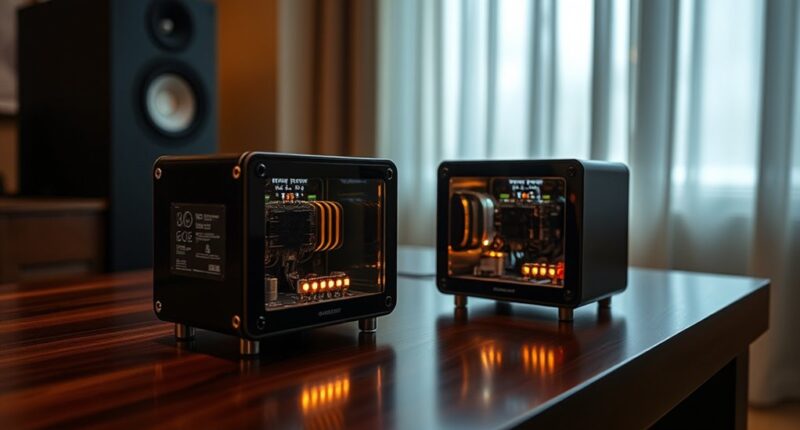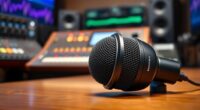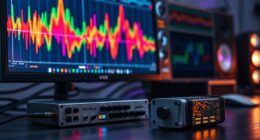Based on my research, the Hotone Omni IR Cab is one of the top IR-based speaker simulators, offering a wide range of cabinet models, easy IR loading, and precise tone control. The Base Amp Box also delivers accurate sound reproduction with its analog design and versatile IR compatibility. Both units provide high-quality IR files, intuitive interfaces, and excellent connectivity, making them ideal for studio and live use. If you want to explore more about these solutions, keep going for all the details.
Key Takeaways
- Look for IR simulators that support extensive IR file compatibility via USB or SD card for diverse tonal options.
- Prioritize units with high-quality IR libraries and the ability to load third-party IR files for authentic cabinet modeling.
- Choose models with detailed EQ controls and multiple cabinet options for precise tone shaping and realism.
- Ensure they offer reliable connectivity, low noise, and proper signal routing to maintain sound clarity.
- Consider cost-to-feature balance, opting for units with advanced IR loading, presets, and authentic tone reproduction within your budget.
Base Amp Box, Analog Base Pedal with Speaker Simulator, Black
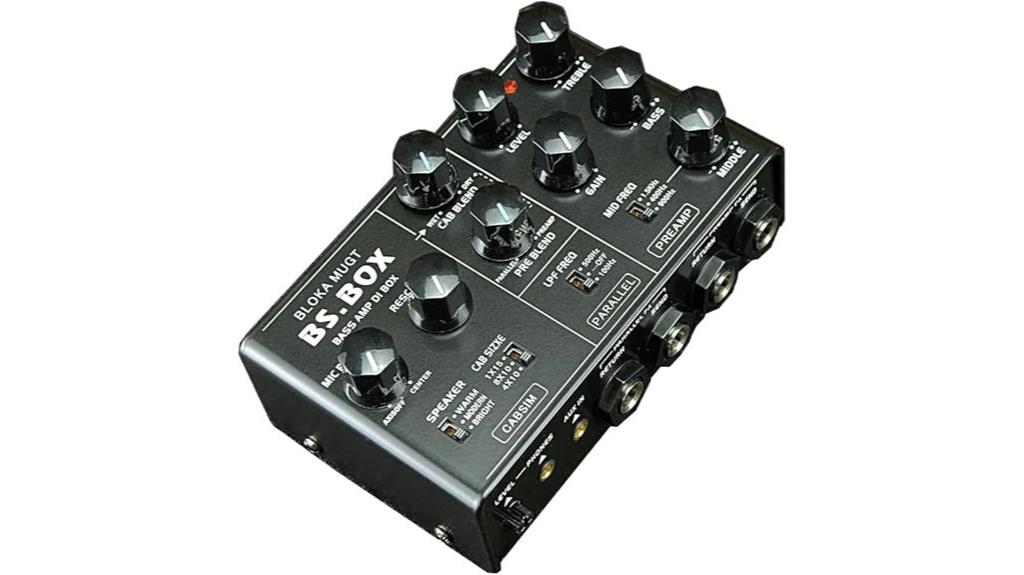
If you’re a bass player looking for a versatile, all-in-one tone solution, the Base Amp Box is an excellent choice. I love how it combines preamp, cabinet simulation, EQ, and DI functions into a single pedal. The modeled preamp, inspired by the Ampeg SVT, offers flexible tone shaping with a 3-band EQ and switchable midrange frequencies. Its cabinet simulator provides three distinct tones, each with adjustable speaker characteristics, resonance, and mic placement. Plus, the dual effects loops let me blend effects and clean signals creatively. This pedal truly empowers me to craft dynamic, professional bass tones—whether for live performance or recording—without needing extra gear.
Best For: bass players seeking a versatile, all-in-one pedal that combines preamp, cabinet simulation, EQ, and effects for live performance and recording.
Pros:
- Offers comprehensive tone shaping with a modeled Ampeg SVT preamp and versatile EQ controls.
- Provides three distinct cabinet simulations with adjustable speaker characteristics, resonance, and mic placement for custom sound.
- Features dual effects loops for complex signal processing and creative tone blending.
Cons:
- May have a learning curve for users unfamiliar with advanced signal routing and effects integration.
- The pedal’s size and multiple controls might be overwhelming for beginners or those with limited pedalboard space.
- As an analog pedal with digital cabinet simulation, it might not perfectly emulate all cabinet nuances compared to high-end modeling gear.
Hotone Omni IR Cab Impulse Response Guitar and Bass Effects Pedal
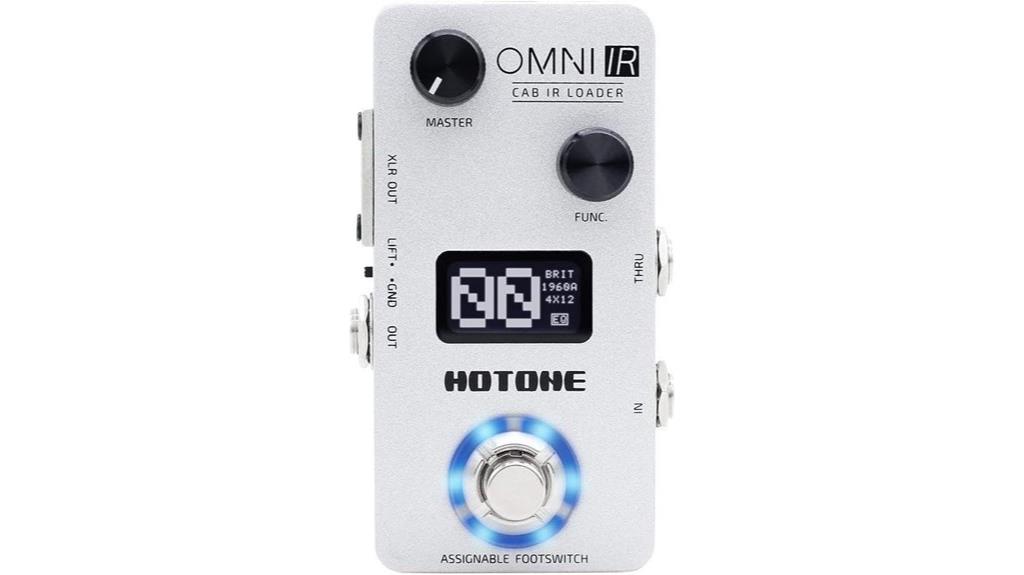
The Hotone Omni IR Cab Impulse Response Guitar and Bass Effects Pedal stands out as an excellent choice for musicians who want versatile speaker simulation with high-quality sound. It offers 40 legendary cabinet models and supports third-party IR files, allowing for customized tone shaping. With 100 presets and a detailed 4-band EQ, you can tailor your sound precisely. The 24-bit conversion guarantees clarity, while the built-in OLED screen and assignable footswitch make navigation easy. Additional features like auxiliary input and headphone output boost its practicality. Powered by a standard 9V supply, this pedal combines flexibility, high fidelity, and user-friendly controls—making it a top-tier IR-based speaker simulator.
Best For: musicians seeking versatile, high-quality speaker simulation and tone customization for guitar and bass with user-friendly controls and extensive preset options.
Pros:
- Supports 40 legendary cabinet models and third-party IR files for customized sound
- 24-bit high-quality A/D/A conversion ensures clear, detailed audio
- Easy-to-navigate OLED display and assignable footswitch enhance user experience
Cons:
- Requires a standard 9V DC power supply, which may limit portability without additional batteries or power options
- Might have a learning curve for users unfamiliar with IR loading and detailed EQ settings
- Limited to USB for IR management, possibly requiring a computer for advanced customization
Factors to Consider When Choosing Speaker Simulators Ir‑Based
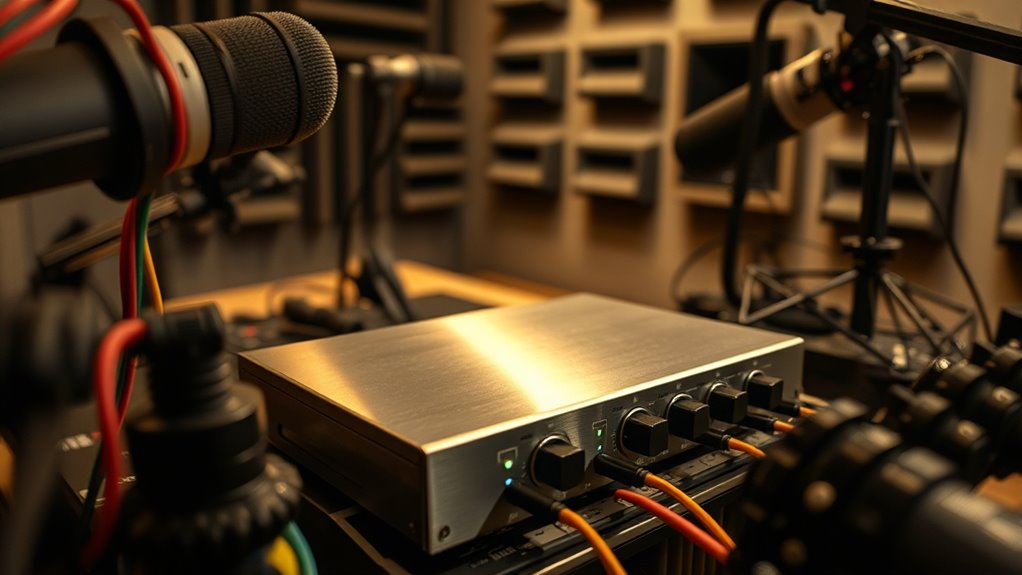
When selecting an IR-based speaker simulator, I focus on factors like IR file compatibility and the variety of cabinet models to guarantee I get the sound I want. I also consider how easy it is to customize tones, navigate the user interface, and connect the device to my gear. Finally, I look at power options to make sure it fits seamlessly into my setup.
IR File Compatibility
Choosing a speaker simulator with compatible IR files is essential for achieving the desired tone and ensuring smooth operation. Different devices support various IR formats like WAV, WAV24, or proprietary types, which can limit your options if they don’t match. It’s important to verify that the IR files you plan to use are compatible with your unit. Many simulators allow loading IRs via USB or SD card, expanding your tonal palette and customization possibilities. Keep in mind that not all IR files are optimized for bass or guitar; checking their frequency response and intended use helps ensure you get the sound you want. Additionally, compatibility with IR management software can simplify organizing, editing, and loading files, making the process more efficient.
Cabinet Model Variety
A broad selection of cabinet models in speaker simulators enhances your ability to craft diverse and authentic tones by replicating different amplifier and speaker setups. The variety of available cabinet models directly boosts the versatility of your sound options, allowing you to match your preferred tone more precisely. Supporting third-party IR files further expands your choices, offering even greater realism and customization. Different cabinet models emulate various speaker materials and geometries, which shape midrange response, resonance, and overall character. Having multiple cabinet options enables nuanced tone shaping and experimentation, essential for achieving unique, professional-sounding recordings or live tones. Ultimately, a wide array of cabinet models provides the flexibility needed to explore and refine your signature sound.
Tone Customization Options
To achieve the perfect tone with an IR-based speaker simulator, it’s essential to pay attention to the available customization options. Many units offer adjustable parameters like resonance, mic position, and speaker color, allowing precise tonal shaping. Support for third-party impulse response files lets you customize cabinet sounds beyond factory presets, giving you more versatility. Detailed EQ controls, such as 4-band or semi-parametric options, enable fine-tuning to match specific speaker characteristics. The ability to blend or switch between multiple cabinet models and IRs provides even greater flexibility for different playing styles and genres. Some units feature intuitive interfaces, like OLED screens and assignable footswitches, making real-time tone adjustments straightforward and quick, ensuring you can dial in your ideal sound effortlessly.
User Interface Ease
An intuitive user interface makes steering IR-based speaker simulators much more straightforward, especially during live performances or quick adjustments. Clear labels on controls help me access essential functions like tone shaping, preset selection, and IR management without confusion. A visual display, such as an OLED screen, offers real-time feedback, making navigation and customization much easier. Assignable footswitches with LED indicators allow seamless switching between presets or effects on the fly, improving my workflow during gigs. Logical organization of knobs and switches minimizes errors and speeds up adjustments during practice or shows. A well-designed interface reduces the learning curve, so I can operate complex IR-based systems efficiently without needing extensive technical knowledge. This ease of use enhances both performance confidence and sound precision.
Connectivity and Power
When choosing an IR-based speaker simulator, ensuring it offers the right connectivity options is vital for seamless integration into my setup. I look for models with 1/4″ instrument outputs, XLR DI, or USB ports to load IR files easily. Verifying power requirements, including voltage and current, is essential to avoid compatibility issues with my existing power supply or pedalboard. I also consider whether the device has a built-in power source or needs an external adapter, ensuring voltage matches my region. Low noise and high headroom are important to maintain clarity at different gain levels. Additionally, I check if the power circuit delivers clean, sufficient power to prevent signal distortion or unwanted noise during performances, ensuring reliable operation and superior sound quality.
Sound Quality Clarity
Choosing a speaker simulator that delivers clear, detailed sound hinges on several technical factors. High-quality IR-based units use 24-bit A/D/A conversion, guaranteeing every nuance is captured and reproduced with precision. The accuracy of cabinet modeling and IR files also plays a vital role; well-crafted impulse responses create a more authentic, transparent tone. Precise control over EQ and resonance parameters helps prevent frequency masking and unwanted artifacts, maintaining clarity across the sound spectrum. Proper signal routing, including dual effects loops, preserves the integrity of the original audio, avoiding unnecessary degradation. Additionally, consistent headroom and a low noise floor guarantee subtle tonal nuances aren’t lost or distorted. All these elements combine to produce a clean, articulate sound that accurately reflects your playing.
Price and Value
The price of IR-based speaker simulators can vary considerably, making it crucial to evaluate what you get for your money. Entry-level models often cost under $100, offering basic IRs and limited features, while professional-grade units can exceed $300, providing more IR slots, better sound quality, and advanced options like customizable EQ and loading capabilities. When gauging value, consider the quality and variety of included IRs—more realistic and diverse cabinet models justify higher prices. Some budget pedals lack features like USB loading or extensive presets, which may limit long-term versatility. Investing in a well-priced unit with expandability and high sound fidelity can deliver better value over time, whether for studio work or live performance. Balancing features and cost ensures you get the most out of your investment.
Frequently Asked Questions
How Do Ir-Based Simulators Compare to Traditional Speaker Cabinets?
IR-based simulators often outperform traditional speaker cabinets in accuracy and flexibility. They use impulse responses to replicate specific speaker and cabinet sounds, offering consistent results every time. Unlike physical cabinets, they’re easier to tweak and customize digitally, saving space and cost. I find them more versatile for different tones, and they eliminate the need for bulky gear. Overall, they’re a game-changer for achieving professional, authentic sound with convenience.
Can Ir-Based Speaker Simulators Emulate Vintage Speaker Tones Accurately?
Yes, IR-based speaker simulators can emulate vintage tones quite accurately. While some purists prefer classic tube amps and vintage cabinets for their character, modern IR technology captures the nuances of those classic sounds, from the breakup to the warmth. I find that with well-crafted IRs, I get that nostalgic tone, blending authenticity with convenience. It’s like having a vintage cabinet in my DAW, ready to deliver that timeless vibe.
Are Ir-Based Systems Suitable for Live Performance Settings?
Yes, IR-based systems are suitable for live performances. I’ve used them on stage and found they provide consistent, high-quality sound that captures different speaker tones accurately. They’re quick to set up and integrate well with live rigs, making my performance smoother. Plus, their realistic speaker emulations help me achieve my desired tone without lugging around heavy amps, which is a huge plus for live gigs.
What Is the Typical Lifespan of IR Files in These Devices?
Think of IR files like vintage vinyl records—they can last for years if well cared for. Typically, IR files in these devices last around 5 to 10 years, depending on usage and storage conditions. I’ve found that regular backups and proper handling can extend their lifespan, much like preserving precious memories. So, with proper care, your IRs can serve you reliably through many performances and recordings.
How Easy Is It to Create Custom IR Profiles for Specific Speakers?
Creating custom IR profiles for specific speakers is pretty straightforward if you have the right equipment. I use a measurement mic and a calibrated audio interface to record the speaker’s response. Then, I process the captured data with specialized software to generate the IR file. It takes some patience and attention to detail, but with practice, I can tailor profiles that perfectly match my speakers, enhancing my sound accuracy.
Conclusion
When choosing an IR-based speaker simulator, I see it’s like selecting the perfect lens for a camera—clarity and detail matter most. Both the Hotone Omni IR Cab and the Analog Base Pedal deliver exceptional sound reproduction, but your choice depends on your needs and setup. I recommend focusing on IR file compatibility and user interface, as they’re the foundation of a seamless experience. With the right tool, your tone will shine like a beacon, crystal clear and true.
